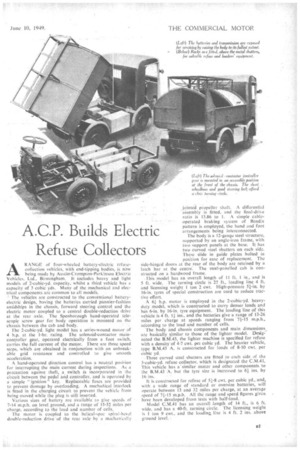A.C.P. Builds Electric Refuse Collectors
Page 9

If you've noticed an error in this article please click here to report it so we can fix it.
ARANGE of four-wheeled battery-electric refusecollection vehicles, with end-tipping bodies, is now being made by Austin-Crompton-Parkinson Electric Vehicles. Ltd., Birmingham. It includes heavy and liebt models of 2-cubic-yd. capacity.' whilst a third vehicle has a capacity of 3 cubic yds. Many of the mechanical and electrical components are common to all models.
' The vehicles are constructed to the conventional batteryelectric: design, having the batteries carried Pannier-fashion amidships in the chassis, forward steering control and the electric motor coupled to a central double-reduction drive at the rear axle. The Spenborough hand-operated telescopic screw gear for body operation is mounted on the chassis between the cab and body.
The 2-cubic-yd. light model has a series-wound motor of 4 h.p. at the 1-hr. rating. The solenoid-contactor maincontroller gear, operated electrically from a foot switch, carries the full current of the motor. There are three speed steps, which are obtained in conjunction with an unbreakable grid resistance and controlled to give smooth acceleration.
A hand-operated direction control has a neutral posilion for interrupting the main current during inspections. As a precaution against theft,. a switch is incorporated in the circuit between the pedal and controller, and is operated by a simple ignition" key. Replaceable fuses are provided to prevent damage by overloading. A mechanical interlock is fitted in the charging circuit to prevent the vehicle from being moved while the plug is still inserted.
Various sizes of battery are available to give speeds of 7-14 m.p.h. on level ground, and a range of 15-32 miles per charge, according to the load and number of cells.
The motor is coupled to the helical-spur spiral-bevel double-reduction drive of the rear axle by a mechanically jointed propeller shaft. A differential assembly is fitted, and the final-drive ratio is 13.86 to I. A simple cableoperated braking system of Bendix pattern is employed, the hand and foot arrangements being interconnected.
The body is a 12-gauge steel structure, supported by an angle-iron frame, with two support panels at the base. It has two curved steel shutters on each side. These slide in guide plates bolted in position for ease of replacement. The side-hinged doors at the rear of the body are retained by a latch bar at the centre'. The steel-panelled cab is constructed on a hardwood frame.
This model has an overall length of 11 ft. 1 in., and is 5 ft. wide. The turning circle is 27 ft., loading line 4 ft. and licensing weight 1 ton 2 cwt. High-pressure 51-in. by 16-in. tyres of special construction are used to reduce tractive effort.
A 6/ h.p. motor is employed in the 2-cubic-yd. heavyduty model, which is constructed to carry denser loads and has 6-in. by 16-in, tyre equipment. The loading line of this vehicle is 4 ft. 11 ins., and the batteries give a range of 13-26 miles per charge at speeds ranging from 71-15 m.p.h.. acCording to the load and number of cells.
The body and chassis components and main dimensions., are basically similar to those of the lighter model. Designated the B.M.43, the lighter machine is specified for refuse with a density of 4-7 cwt per cubic yd. The heavier vehicle, type B.M.43 -A, is constructed for loads of 8-10 cwt. per cubic yd.
Three curved steel shutters are fitted to each side of the 3-cubic-yd. refuse collector, which is designated the C.M.41, This vehicle has a'similar motor and other components to the B.M.43 A, but the tyre size is increased to 61 ins. by 16 ins.
It is constructed for refuse of 51-8 cwt. per cubic yd., and, with a wide range of standard or oversize batteries, will operate between 13 and 32 miles per charge, at an average speed of 71-15 m.p.h. All the range and speed figures given have been developed from tests with half-load. Model C.M.41 has an overall Jength of 14 ft., is 6 ft. wide, and has a 40-ft. turning circle. The licensing weight is I ton cwt., and the loading, line is 4 ft. 2 ins, above ground level.


























